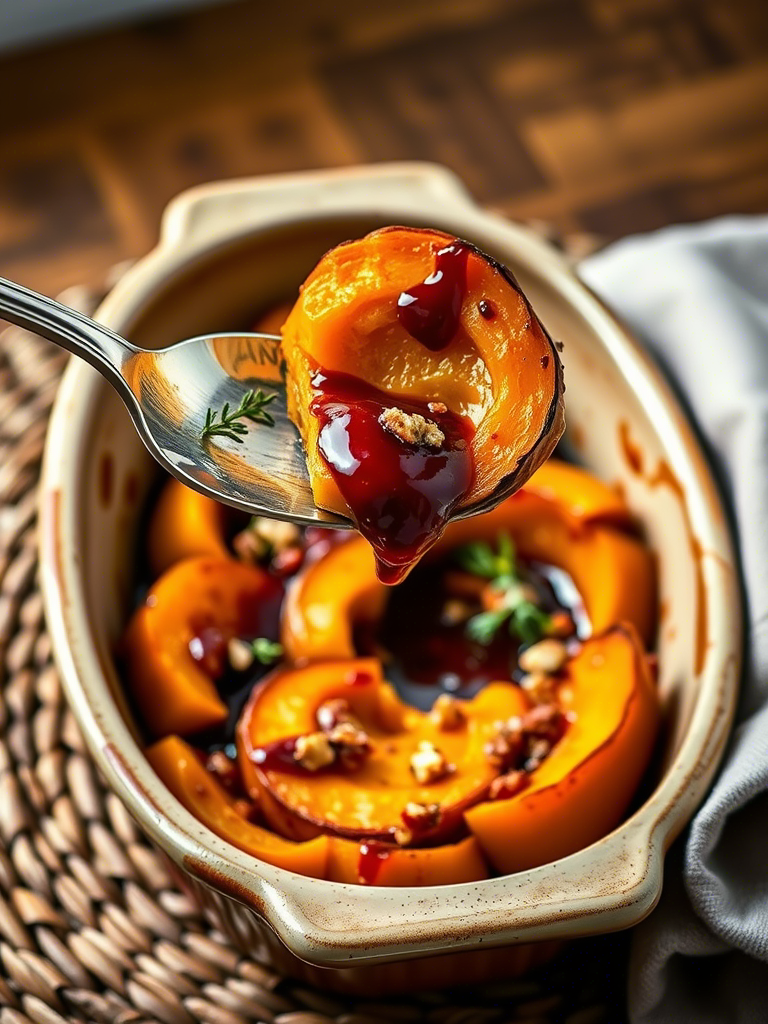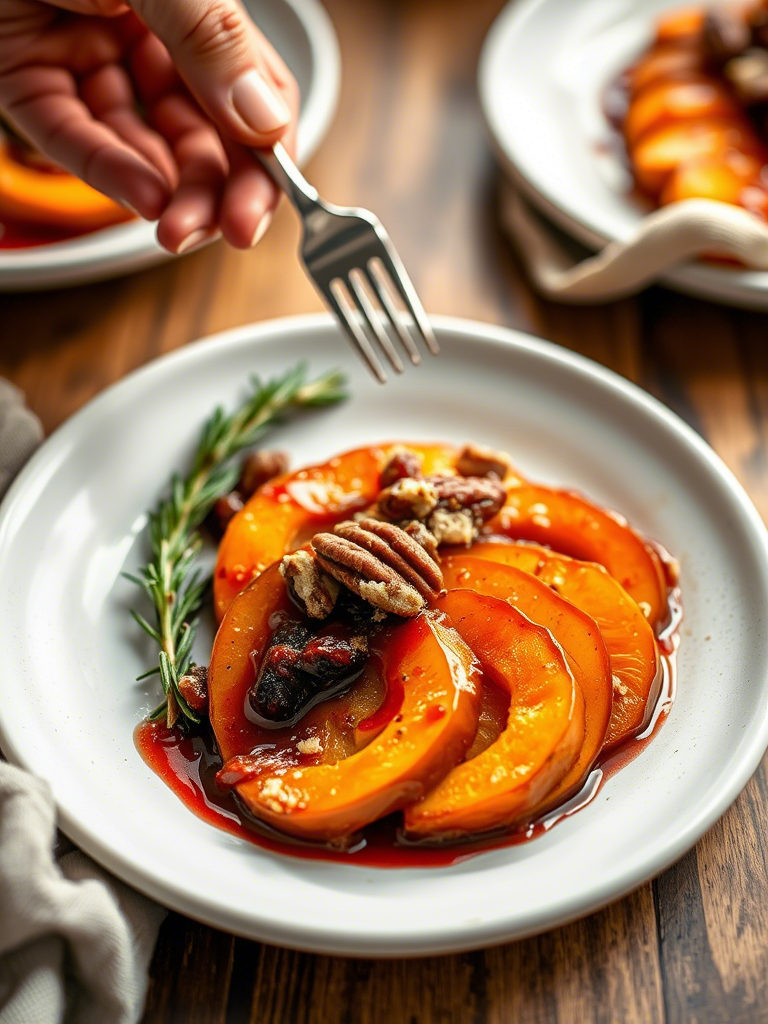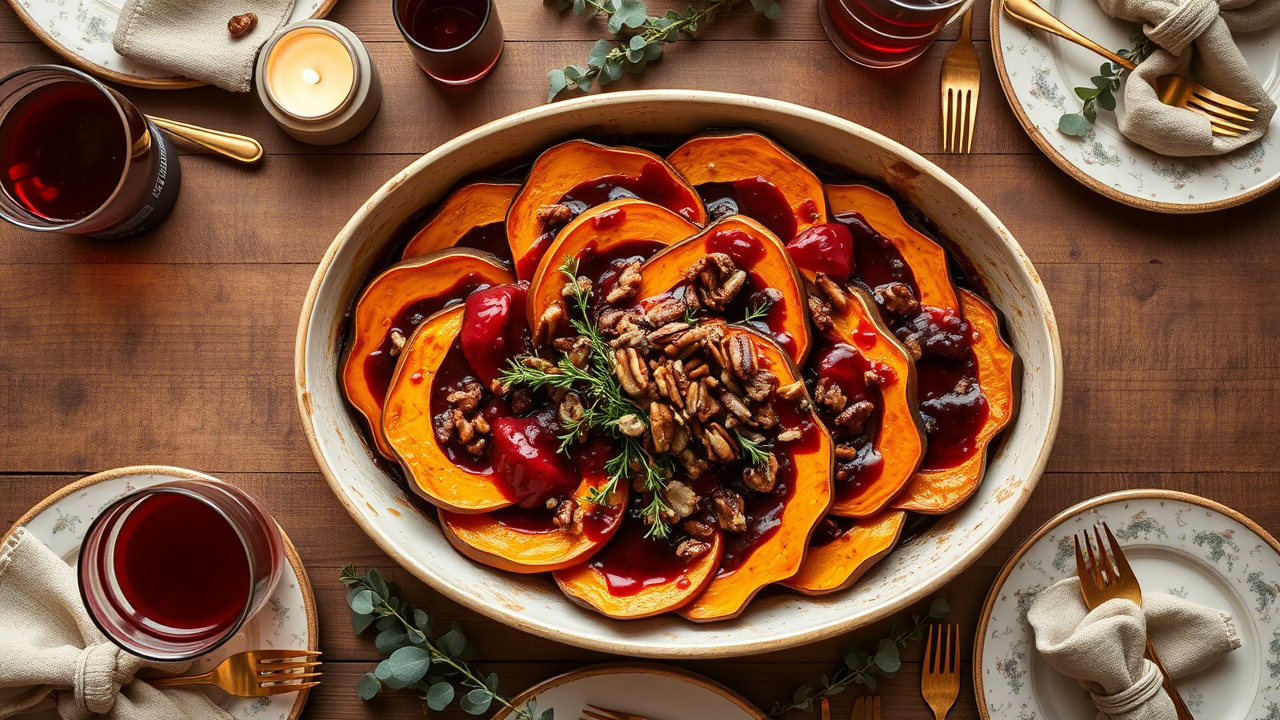Let’s get something straight — if you think butternut squash is boring, you’ve never let it tango with a cranberry glaze. This ain’t just another roasted veggie dish destined to be pushed around the edge of a holiday plate. No. This is your centerpiece in disguise. A dish so rich in color and bold in contrast, it tastes like autumn dipped itself in a pot of syrupy sass and decided to show up sweet, savory, and unapologetically bright.
We’re diving deep into what makes Cranberry-Glazed Roasted Butternut Squash a sleeper hit among chefs who actually care about flavor balance, texture contrast, and, frankly, not wasting time on things that don’t slap. I’m not talking mass-market holiday fluff here. This is sharp culinary strategy cloaked in festive comfort.
The Unexpected Brilliance of Butternut Squash
Butternut squash, though often underestimated, is a flavor chameleon. It leans sweet but holds savory well. That dense, silky texture? A natural canvas for high-acid, high-sugar glazes that cut through its richness like a well-sharpened chef’s knife through cold butter.
What makes butternut squash particularly perfect for this application is its high beta-carotene content. According to a USDA nutrient database, one cup of cooked butternut squash delivers over 450% of your daily vitamin A needs. That’s not just a health flex — it’s a clue. That nutrient-dense, low-moisture interior means it roasts beautifully without collapsing into mush. Crucial.
Slice it right, season it aggressively, and roast it hot. Caramelization is the entire point. Under-roasting? It’s a sin. You want those edges barely flirting with burnt. That’s where flavor lives.
Why Cranberry?
Cranberries bring more than just color. They pack a one-two punch of malic and citric acid, giving them that signature tartness chefs crave for balance. It’s like using vinegar, only better-looking and with a seasonally appropriate attitude.
When reduced into a glaze, cranberries offer depth you can’t get from your standard glaze suspects like balsamic or maple. And yes, you can throw some maple syrup in there — but use it as a whisper, not a scream. The cranberries should lead.
Real-world application? A 2019 flavor trend report by Technomic highlighted tart fruit glazes as an emerging profile in fine dining, often paired with rich vegetables or fatty meats. Think pork belly with pomegranate reduction. This is a similar profile — just on the veg side of things.
Building the Glaze: It’s Not Jam, Don’t Treat it Like One
You’re not making preserves. You’re building a glossy, clingy lacquer. That means sugar, yes — but also vinegar, aromatics, and heat control.
A professional-grade cranberry glaze usually starts with:
- Fresh or frozen cranberries (never canned — don’t even).
- A neutral or light brown sugar for depth.
- White wine vinegar or apple cider vinegar for brightness.
- A touch of Dijon or grainy mustard (optional but highly recommended).
- Maybe a clove or two — but only if you’re feeling spicy and restrained.
Simmer low. Mash slightly. Strain or don’t. If you’re cooking for a crowd that respects texture, leave it rustic. Otherwise, blitz and strain for a sleek finish.

Roasting That Squash: Precision with a Dash of Reckless Heat
Peeling a butternut squash is nobody’s favorite task. Get yourself a sharp Y-peeler and thank me later. Cut the squash into half-moons or wedges — no tiny cubes, please. You want heft. Surface area matters here. More contact = more browning.
Season boldly. I go with:
- Olive oil
- Kosher salt
- Cracked black pepper
- Smoked paprika (adds warmth and color)
- Garlic powder (no shame here)
Roast at 425°F (218°C). No lower. Any less, and you’re just steaming your squash while pretending you’re roasting it. Flip once. Don’t overcrowd the pan. Use parchment or a bare sheet tray — avoid silicone mats; they prevent the Maillard reaction from doing its magic.
Roast time? Around 30-40 minutes, depending on your slice thickness. You’ll know it’s ready when the edges go crisp and bronze, and the inside holds its shape but yields to a fork. Think al dente — but for squash.
Assembly: It’s All About Timing
Don’t glaze during roasting — it’ll burn. That sugar content’s too high. Instead, glaze after the roast while the squash is still piping hot. It’ll absorb the glaze slightly while keeping a glossy finish. Toss gently. Don’t break the slices. Show them some respect.
For extra impact? Garnish.
- Toasted pecans or walnuts (texture).
- Crumbled goat cheese or feta (contrast).
- Chopped parsley or fresh thyme (freshness).
- Orange zest (brightness).
You’re layering. You’re not just feeding people — you’re architecting a mouthful that makes someone stop mid-bite and say, “Wait… what is this?!”
Advanced Applications: From Side Dish to Center Stage
This dish doesn’t have to stay a side. It can anchor a vegetarian main course if treated with intention.
Try:
- Serving it over a warm farro pilaf with pomegranate seeds and caramelized onions.
- Layering it on grilled sourdough with a schmear of ricotta and drizzle of the glaze.
- Folding the glazed squash into a grain bowl with quinoa, shaved Brussels sprouts, and toasted pumpkin seeds.
Chefs in progressive kitchens have begun using sweet glazes on vegetables to mimic the satisfaction of umami-rich meat dishes. It works. People remember it.

Common Pitfalls and How to Dodge ‘Em
1. Undercooked squash: This ain’t no salad bar. Roast it until it’s truly cooked through and the outside’s caramelized. Squash that’s too firm? Texturally jarring.
2. Over-glazing: A little goes a long way. You’re not making candy squash. The glaze should compliment, not drown.
3. Unbalanced glaze: Taste the glaze before it hits the squash. Too sour? Add a touch more sugar. Too sweet? Splash more vinegar. Lifeless? Salt, mustard, or citrus zest can wake it up.
4. Wrong pan choice: Glass and ceramic can inhibit browning. Use metal sheet trays. Trust me.
5. Using canned cranberry sauce: Don’t. Just don’t. It’s too gelatinous, too sugary, and smells like a nursing home Thanksgiving.
Pro Tips and Chef Tricks
- Try roasting squash with halved shallots or red onion wedges. They pick up the glaze beautifully.
- Add a touch of Aleppo pepper to the glaze for mild heat that doesn’t fight the cranberries.
- Want to go gourmet? Infuse the glaze with a cinnamon stick or star anise — just don’t forget to remove it before tossing.
Also: don’t sleep on cold leftovers. Glazed squash straight from the fridge, with some arugula and sherry vinaigrette? That’s a chef’s secret lunch right there.
Final Thoughts: The Dish That Surprises Everyone, Every Time
Cranberry-Glazed Roasted Butternut Squash is one of those recipes that lives in the overlap of festive, health-conscious, chef-approved, and straight-up delicious. It respects the ingredients. It balances sweet and savory. And it’s easy to scale, modify, and impress with.
It also photographs like a dream. That red glaze on orange flesh? Pure clickbait. Great for social media, but even better for the soul.
Whether you’re plating for a 200-cover holiday dinner or just sick of basic side dishes, this is a recipe that earns its spot every time. It doesn’t whisper special — it shouts it.
So next time you’re staring at a sad pile of winter squash thinking “what now,” remember: all it takes is a tangy crimson coat and a little heat to turn humble into unforgettable.
FAQs
What type of squash works best for this recipe?
Butternut squash is ideal due to its sweet flavor and firm, roast-friendly texture.
Can I use canned cranberry sauce for the glaze?
No — it’s too sweet, too thick, and lacks the brightness of fresh cranberries.
Should I peel the squash before roasting?
Yes, always peel it; the skin becomes leathery and unpleasant when roasted.
Can I make the cranberry glaze ahead of time?
Absolutely — store it in the fridge for up to 5 days and reheat gently.
What’s the best temperature to roast the squash?
Roast at 425°F for deep caramelization and tender flesh.
Can I add other vegetables to roast with the squash?
Yes, red onions or shallots work great and soak up the glaze beautifully.
How do I prevent the glaze from burning?
Always glaze after roasting, never during, to avoid sugar burn.
What herbs pair well with this dish?
Fresh thyme, parsley, or sage all complement the glaze and squash.
Can this dish be served cold?
Yes — it’s surprisingly delicious chilled in salads or grain bowls.
Is this recipe suitable for vegans?
Yes, it’s entirely plant-based as long as you skip cheese garnishes.

Mariana is a passionate home cook who creates delicious, easy-to-follow recipes for busy people. From energizing breakfasts to satisfying dinners and indulgent desserts, her dishes are designed to fuel both your body and hustle.
When she’s not in the kitchen, she’s exploring new flavors and dreaming up her next recipe to share with the Foodie Hustle community.

